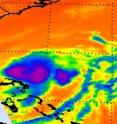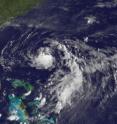NASA's infrared satellite data shows warming cloud tops in Tropical Storm Bret
Tropical Storm Bret's cloud tops are getting warmer on NASA infrared satellite imagery. That's an indication that the cloud top heights are dropping and Bret is weakening. High cloud tops in thunderstorms are a clue that there's strong convective uplift. Uplift is the force of warm, moist, and unstable air upward into the atmosphere that condenses into the thunderstorms that power a tropical cyclone. When the uplift is weak, the convection is weak and thunderstorms are less intense than they could be. Bret is now experiencing a weaker convective uplift.
The Atmospheric Infrared Sounder (AIRS) instrument on NASA's Aqua satellite took an infrared look at Tropical Storm Bret on July 18 at 17:53 UTC (1:53 p.m. EDT). It showed cold high thunderstorm cloud tops to the south and west of the center of circulation. The coldest cloud top temperatures were cold as -63 Fahrenheit (-52 Celsius).
So what caused the weakening in uplift and thunderstorm creation? Dry air moved into the center of Tropical Storm Bret and sapped the energy (moisture). Infrared data from AIRS on early on July 19 showed that strong convection and strong thunderstorms have almost disappeared from Bret's center.
At 5 a.m. EDT on July 19, Bret's maximum sustained wind were near 50 mph. It was located about 205 miles north-northeast of Great Abaco Island, bear 29.3 North and 76.4 West. In relation to the U.S. mainland, it's about 410 miles (660 km) south of Cape Hatteras, N.C. Bret continues to move to the open waters of the Atlantic in a north-northeasterly direction at 7 mph (11 kmh). Minimum central pressure is near 1000 millibars.
The National Hurricane Center noted today that all watches and warnings have been dropped. The forecasters there also expect Bret to speed up in the next day or two. Over that time, Bret will continue battling dry air and increasing wind shear. Those two ingredients will help weaken Bret. As a result of those two factors, the National Hurricane Center forecast indicates that Bret will likely dissipate by the weekend.
Source: NASA/Goddard Space Flight Center
Articles on the same topic
- NASA catches 3 tropical cyclones at 1 timeSat, 23 Jul 2011, 2:33:59 UTC
- GOES satellite sees a triple header in the tropicsSat, 23 Jul 2011, 2:33:22 UTC
- NASA sees Tropical Storms Bret and now Cindy frolic in North AtlanticThu, 21 Jul 2011, 15:39:25 UTC
- NASA satellites confirm Tropical Storm Bret's heaviest rains on the eastern sideWed, 20 Jul 2011, 15:34:11 UTC
- GOES-13 movie catches Tropical Storm Bret form and intensifyTue, 19 Jul 2011, 15:37:04 UTC
Other sources
- NASA catches 3 tropical cyclones at 1 timefrom PhysorgSat, 23 Jul 2011, 8:00:37 UTC
- NASA catches three tropical cyclones at one timefrom Science DailySat, 23 Jul 2011, 2:30:17 UTC
- NASA sees Tropical Storms Bret and now Cindy frolic in North Atlanticfrom PhysorgThu, 21 Jul 2011, 15:31:09 UTC
- GOES satellite sees a triple header in the tropicsfrom PhysorgWed, 20 Jul 2011, 21:02:53 UTC
- NASA satellites confirm Tropical Storm Bret's heaviest rains on the eastern sidefrom PhysorgWed, 20 Jul 2011, 16:31:46 UTC
- NASA's infrared satellite data shows warming cloud tops in Tropical Storm Bretfrom PhysorgTue, 19 Jul 2011, 15:31:57 UTC
- GOES-13 movie catches Tropical Storm Bret form and intensifyfrom PhysorgMon, 18 Jul 2011, 16:30:51 UTC

